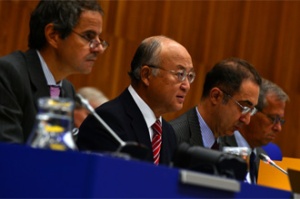By Greg Thielmann and Kelsey Davenport
The Associated Press reported from Vienna September 11 that the International Atomic Energy Agency (IAEA) has received "new and significant intelligence" regarding the potential military dimensions of Iran's nuclear program, particularly in the area of computer modeling for the explosive yields of warheads. Close examination of previous IAEA reporting suggests that this intelligence may be significant, but it is not entirely new. The intelligence on computer modeling referred to by AP could represent greater detail on evidence supporting past allegations of activities related to developing a nuclear-weapons program, rather than evidence of new nuclear weapons related work. In an annex of the IAEA's November 2011 report to the Board of Governors on Iran's nuclear program, the agency documents information provided by member states regarding Iran's work with computer modeling studies. These studies included modeling and calculations on "subsequent nuclear explosive yield." The annex reported that the IAEA saw models and "the results of these calculations." The studies were alleged to have been conducted in 2008 and 2009. These past IAEA characterizations are consistent with what appears in the AP story – that is, Iran "advanced" its nuclear capabilities by using computer modeling to calculate the "destructive power" of nuclear weapons "sometime within the past three years." The novelty in the AP report is that two of the six diplomatic sources allege Iran continued the studies "past 2009" and "has moved closer to the overall capability to develop a nuclear weapon." The AP story also references the most recent IAEA report to the Board of Governors, as indicating the agency obtained new evidence concerning Iranian nuclear weapons related activities. The article mentions that this "new and significant intelligence" is alluded to in the August 2012 report and quotes four of the six diplomatic sources as saying: "'the agency has obtained more information which further corroborates' its suspicions." However, the language from the August 2012 report harkens back to the analysis contained in the 2011 report's annex; it does not attempt to revise its substantive conclusions: "[s]ince November 2011, the Agency has obtained more information which further corroborates the analysis contained in the aforementioned Annex [from the November 2011 report]." Thus this "new and significant intelligence" could merely reflect the strengthening of evidence on activities already documented by the IAEA, not indicating new possible military dimensions. Evidence indicating that Iran is working toward a nuclear weapons breakout capability must be taken seriously by the IAEA and international community. At the very least, the IAEA's evidence should stiffen the resolve of the agency's Board of Governors and of the UN Security Council to insist that Iran open up its nuclear program, past and present, to greater scrutiny. But the new evidence should also be understood within the context of the activities that the agency has already documented and has already pressed Iran to explain. Evidence of computer modeling that could have taken place more than two years ago is far from the threshold of proof that is necessary to say that Iran has developed a rapid breakout nuclear capacity. Nor does it suggest that Iran has crossed a U.S. "red line" that could prompt a resort to military force.

